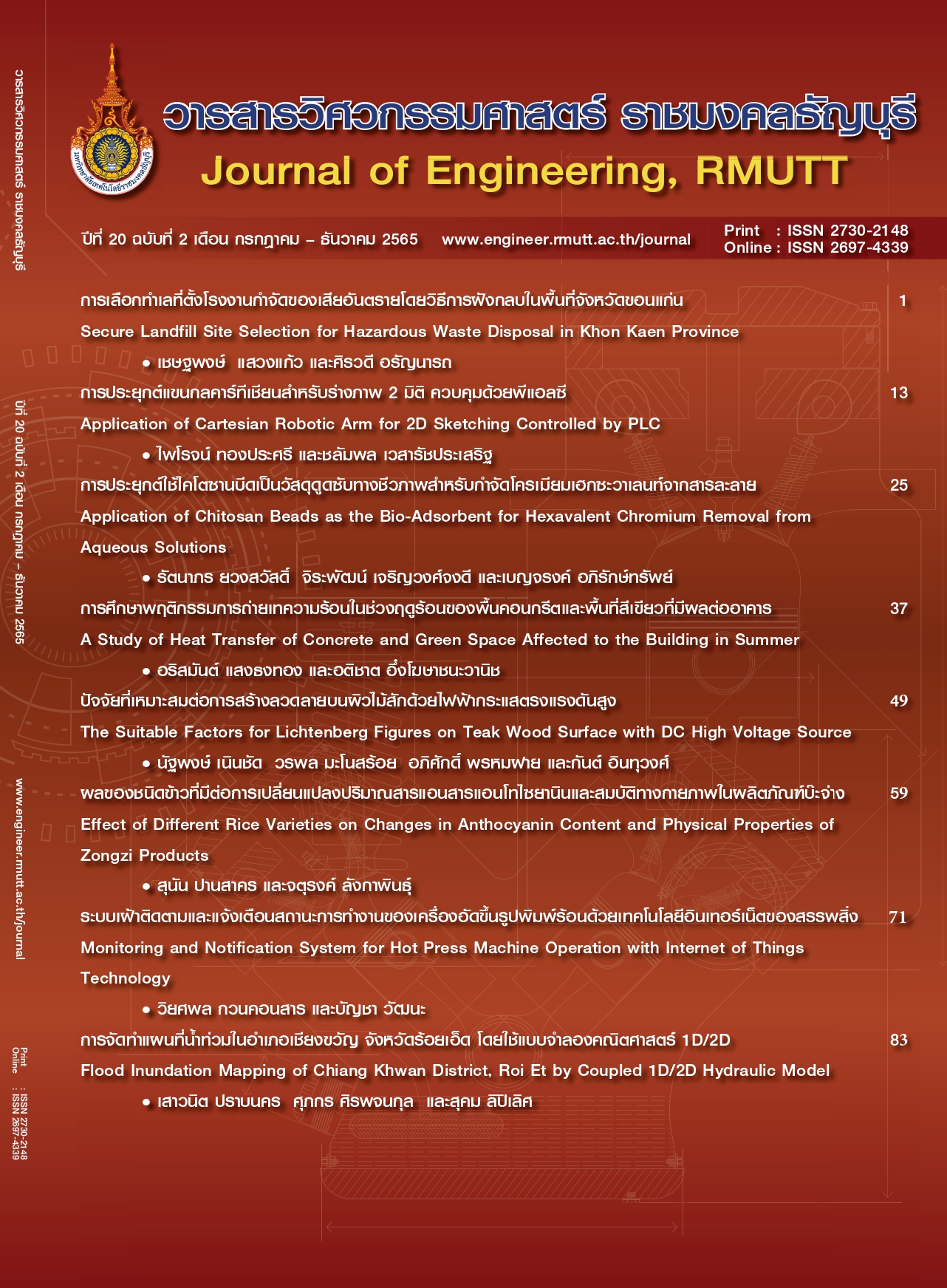A Study of Heat Transfer of Concrete and Green Space Affected to the Building in Summer
Main Article Content
Abstract
The objective of this study is to study Heat Transfer of concrete and greenfield that affected to the building in summer by record the temperature in each thickness of the two surfaces at depth levels of -15.00 cm, -7.50 cm and 0.00 cm respectively, for ambient temperature is recorded every 1 minute, 24 hours a day, for 7 days under the suburbs area conditions, where without any tall buildings, there are only about the same size of buildings of the 30% surface around the building from the total area 100% on a sunny day. The data of temperatures at different depths of the same surface and the same depth at the different surface during the day and night for explain the heat transfer by using the diffusion equation to analyze the temperature occurring in the building. This research results that vertical heat transfer in different areas was affected incomplete transfer temperature due to there is blocking of heat transfer to the next layer. For this reason, the horizon heat transfer to the same areas is better than transfer to the building. So, the building floor that are surrounded by greenfield has less heat accumulation than the building floor that are surrounded by concrete. Therefore, in the summer, the concrete floors surrounding the buildings show accumulate heat level higher than the green space, both of during the day and night.
Article Details

This work is licensed under a Creative Commons Attribution-NonCommercial-NoDerivatives 4.0 International License.
The manuscript, information, content, picture and so forth which were published on Frontiers in engineering innovation research has been a copyright of this journal only. There is not allow anyone or any organize to duplicate all content or some document for unethical publication.
References
Khamchiangta D, Dhakal S. Physical and non-physical factors driving urban heat island: case of Bangkok metropolitan administration. Thailand. Journal of Environmental Management. 2019, 248:1-13. (in Thai)
Puljan V, Luangwilai T, Welamas W, Meechowna S, Leelayuth S, Moodleah S. Investigating the behavior of heat transfer through building walls with different covering materials by using Method of Lines (MOL). NKRAFA Journal of Science and Technology. 2021;17(1):1-10. (in Thai)
Nuntasiri P, Rasisuttha S. Thermal comfort of low income people: case study of Baan Mankong Non Nong Wat 2. Academic Journal: Faculty of Architecture, Khon Kaen University. 2558;14(2):127-41. (in Thai)
Intaraksa A. Role of latent heat flux and sensible heat flux in urban zoning, design and planning [dissertation]. [Bangkok (TH)]: Kasetsart University; 2014.
Lamananchai T. Weather warning. Thai Meteorological Department; 2022.
Weather report on 2021. Available from: https:// www.tmd.go.th/province_weather_stat.php?StationNumber=48455
Teanmanee T. Urban heat island and urban physical environment [master’s thesis]. [Bangkok (TH)]: Silpakorn University; 2022.
Rasitanon T. The thermal comfort and adaptability to living for Muslim on the coast area Songkhla province [master’s thesis]. [Songkla (TH)]: Prince of Songkla University; 2010.
Takkanon P. Thermal comfort: basic and models for hot and humid climates. Journal of the Faculty of Architecture Silpakorn University. 2005;21:133-46. (in Thai)
rivanit M, Auttarat S. The summer thermal environment and human comfort of shaded outdoor and semi-outdoor spaces to living in the urban area of Chiang Mai city. Journal of Architectural/Planning research and studies (JARS). 2015;12(2):53-72. (in Thai)
Norkaew S, Sangkaew Y, Yarak P, Wisetmuenwai O, Ketsakorn A. Assessment of indoor air quality in the lecture room of undergraduate students in a university in Pathumthani province. Journal of Safety and Health. 2022;15(1):173-86. (in Thai)
Khetkrathok N, Suluksna K. Guidelines for the management of thermal comfort conditions in air-conditioned areas for energy saving case study library building Suranaree university of technology. Ladkrabang Engineering Journal. 2019;36(1):17-24. (in Thai)
Wattanavichin P. The experimental study of thermal behavior with Phase Change Material Thermal Shield (PCMTS) inside lightweight wall during the daytime [thesis]. [Bangkok (TH)]: Thammasat University; 2015.
Wongkhunkaew P, Konyai S. Effect of climate variability on sugarcane production of northeastern Thailand. 22nd National Graduate Research Conference. 2021:7-14. (in Thai)
Ruengsillapanun K, Udtaranakron T, Pulngern T, Tangchirapat W, Jaturapitakkul C. Mechanical properties, shrinkage, and heat evolution of alkali activated fly ash concrete. Construction and Building Materials. 2021;299:1-14.
Liqun H, Yangyang L, Xiaolong Z, Shaowen D, Zhuangzhuang, Hao L.H. Temperature characteristics of porous portland cement concrete during the hot summer session. Hindawi Advances in Materials Science and Engineering. 2017:1-10.


